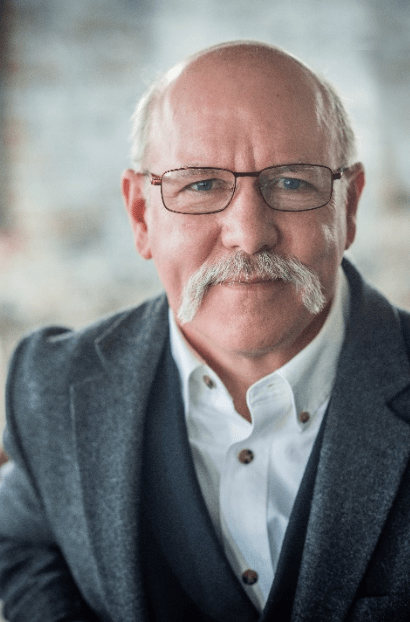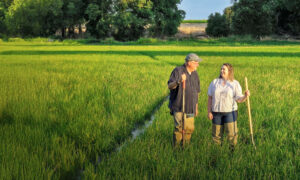Among the many discussions happening regarding regenerative agriculture, there’s an ongoing dialogue about how to define it. Some have suggested that it’s far too soon to define the growing movement, while others have debated a data-centric approach to proving out its promises of improved soil health, greater carbon sequestration, enriched ecosystems, and more nutritious, environmentally-friendly meat.
The Rodale Institute is not only attempting to define regenerative agriculture, it’s also launching an entirely new food label: regenerative organic.
“If you don’t have a high set of standards that people can strive for and adhere to, you end up with a race to the bottom trying to market something that is just regenerative or organic without doing the work of being either,” Jeff Moyer, Rodale Institute CEO, told AFN. ”We are concerned about that so we worked with some major brands like Dr. Bronners and Patagonia. We had an extensive listserv dialogue for almost a year to get feedback from the community around the word regenerative and feel like we are in the best position to claim territory around the word.”
Rodale is a 501(c)(3) non-profit that supports research into organic farming. Founded in 1947 by author G.I. Rodale, his son later carried on his father’s legacy by establishing a 333-acre farm in Pennsylvania dedicated to researching and advancing organic agriculture. Today, it’s involved with numerous facets of the organic world including a Next Generation Scholarship Fund for farming interns and its recently launched Midwest Organic Center in Iowa dedicated to boosting organic adoption among Midwest farmers.
Moyer has worked with Rodale for 43 years, providing him with a unique perspective on the movement and the uprise of regenerative agriculture. He was recently appointed as the organization’s new CEO.
As the movement has gained notoriety, there have been a number of attempts to describe the relationship between organic and regenerative. Some see them as complements of one another while others think that the USDA National Organic Program (NOP) should be updated to include its new cousin. Some, however, accuse regenerative as merely parading the original fundamentals that the organic movement advocated for, mainly when it comes to focusing on soil.
But the regenerative organic label is not exactly a new concept. In fact, Moyer describes the two concepts as having been linked for much longer than most people would presume.
A dirty homecoming for organic fundamentalists
“We’ve seen marketing people using the word sustainable because it means everything and nothing at the same time. People have suddenly realized that regenerative is out there and that there may be some opportunities for change or marketing around that word,” he explains. “People have been using that word and making it their own without really saying what it means. We felt like organic and regenerative have always been our words, Rodale words, and we want to step up and create a standard that links those two words together.”
During the 1980s with G.I. Rodale’s son, Bob, at the institute’s helm, the organization determined that allowing the USDA to take ownership of the word organic and to adopt regulations and standards to regulate its use in food labeling was the best way forward. This led to the enactment of the 1990 Organic Food Production Act and the creation of the National Organic Program. For some, however, relinquishing the word to government control resulted in certain outcomes and compromises that diluted the movement’s intentions.
The opportunity to create a new label that returns the organic program’s focus to soil health will undoubtedly be a celebratory occasion for many organic champions. The legislative history of how the organic movement became codified into a set of regulations giving rise to the USDA-enforced National Organic Program (NOP) is a complicated one. The regulations have allowed for the certification of hydroponic farming systems as organic, for example, creating rampant controversy with organic traditionalists who believe soil health is the heart of the ethos. A soil-less system, therefore, is a poor fit for its methodologies.
“When you give something to the government, you give up some things. That’s just how it works,” Moyer says. “Rodale understood that and still thought it was worth doing. It meant giving up the idea of continuous improvement, links to social justice, and language that organic farmers held near and dear around soil health and animal welfare. But we ended up with a complex and robust strategy for regulating the word organic and the industry has grown.”
Today, a wide variety of farming operations are certified organic, including large-scale dairy businesses that have struck some people as being too closely akin to an industrialized confinement-based livestock operation to truly be organic in the fundamental sense of the word. The Cornucopia Institute has been outspoken regarding the issue of organic “mega-dairies” recently issuing a report detailing how some dairies milking as many as 15,000 cows in desert climates have obtained organic certification under the NOP.
When it comes to regenerative, some have suggested that the NOP’s regulations simply be updated to encompass regenerative agriculture; Moyer will be the first to tell you that promulgating new regulations is a process that’s not for the faint of heart. Take the recent attempt to add animal welfare standards to the NOP as an example, something that is best described as a rulemaking rollercoaster.
“We tried to include stiffer regulations around animal welfare and we have been told under the current administration that it’s never going to happen. I chaired the National Organic Standards Board in 2010 as they worked on the livestock regulations,” Moyer says. “It’s a cumbersome process to make change happen within the standards.”
Here’s what Rodale’s Regenerative Organic means
So what is the new label exactly?
“It’s organic with additional language around it. The organic standard is relatively weak around terminology in soil health to the point where we can certify hydroponic systems without any soil at all,” Moyer explains. “It includes three additional pillars: soil health, animal welfare, and social justice.”
The soil health rules call for something green and growing covering the soil for as many days of the year as possible, while the animal welfare regulations reflect standards from the Animal Welfare Approved third-party certification program. Social justice reflects the desire to pay farm laborers a fair wage, access to a grievance policy, and sanitary working conditions.
It also includes the concept of continuous improvement. Producers who seek the new label will need to show that they are continuously trying to improve their farms. As a testament to the importance placed on continuous improvement, the label offers three levels: bronze, silver, and gold.
“You can stay at bronze for a few years but if you haven’t moved to silver, are you really trying to improve your operation? You can stay at silver because going from silver to gold is going to be a challenging set of high standards,” Moyer explains. “We are still in the testing phase and some changes may be made.”
… don’t worry, Moyer knows there’s an elephant in the room
Labeling fatigue.
Can consumers really handle another label claim? Studies show that consumers do check food labels but frequently misunderstand or make assumptions about what the labels mean. A food package is no longer only adorned with USDA and FDA labels either. Third-party certifications regarding GMO usage, animal welfare, and other virtue-related aspects that tout the supremacy of the product inside, have also squeezed their way onto packaging, making most food items look more like they’ve fallen victim to an unsupervised toddler’s sticker book.
“This is a legitimate concern. We do struggle with the idea of adding to that label fatigue,” Moyer explains. “We know that the word organic is already out there, so by linking to organic, we hope it will capture part of the marketplace that values that. We have a bit of an uphill push to get the label on people’s radar but we are here for the long-term. We have been here 70 years and we will be here 70 years from now and by then ‘sustainable’ will be long gone.”




